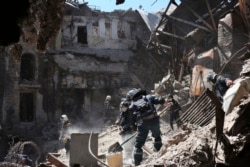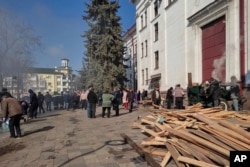On March 16, an airstrike hit the Donetsk Academic Regional Drama Theater in Mariupol, where civilians sheltered amid a Russian offensive.
Russia’s siege of the port city concluded on May 20, after Ukrainian forces there surrendered. Located in Ukraine’s eastern Donetsk region, Mariupol is now controlled by Russian proxy fighters of the self-proclaimed Donetsk People’s Republic (DNR).
Now, one month into Russia’s occupation, a DNR “investigator” claims there were no civilians in the theater at the time of the attack.
“If at once there were a large number of civilians, as eyewitnesses show us, then, closer to the day of the tragedy, there were actually no civilians left in the drama theater,” Aleksei Kutsurbenko told Russian state broadcaster Sputnik.
“Yes, as we have established, there was a food and humanitarian aid distribution point, and civilians came and ate there, but there were a small number of them.”
This portrayal is false. Credible reporting and witness accounts have established that the strike caused extensive civilian casualties. Russia has made numerous false claims about the incident, including that Ukrainian forces were responsible for the attack, as part of a broad pattern to misrepresent Russian military attacks on Ukrainian civilian infrastructure as “provocations.”
Although Sputnik’s English-language report make no mention of casualties, its Russian-language version said the remains of 14 victims were found.
That report implies that the 14 dead were not civilians. Citing Kutsurbenko, the Sputnik report states that civilians had left the theater by the time of the explosion, adding that Ukrainian forces had “set up firing positions” inside.
The report further cites Russia’s Defense Ministry, which claimed the building was blown up as a “bloody provocation” committed by the Azov Regiment, an all-volunteer unit formed to fight Russia’s clandestine invasion of Ukraine in 2014 (and later incorporated into Ukraine’s National Guard. Russia has spread false claims that the regiment is infiltrated by nazis.).
With Russian occupation forces closing off access to investigators and hauling the rubble away, the exact number of casualties is unknown. But numerous witness accounts contradict Russia’s claims.
An investigation by the Associated Press (AP) published in May estimated 600 civilians were killed in the Mariupol theater airstrike — twice the number given by the Mariupol City Council.
The AP investigation drew on testimony from 16 “direct witnesses,” most of whom were inside the theater. The AP methodology used to calculate that death toll is available here.
After Russia launched its siege of Mariupol, city authorities ordered that the theater be used as a makeshift bomb shelter because of its size, sturdy build and large basement, AP reported. By March 15, around 1,200 people had reportedly taken shelter there.
The Ukrainian word for “children” was written outside the front and back of the theater in giant bold letters large enough to be read from satellites.
The presence of women and children in the theater is well-documented.
Survivors said about 1,000 people were inside at the time of the 10 a.m. airstrike. They also estimate “upwards of 100 people” were at a field kitchen outside the theater. Survivors told the AP everyone at that kitchen was killed by the strike.
Amnesty International released a report in June which, drawing on 53 first-hand testimonies, including 28 people who were “inside or adjacent to the theater,” also contradicts Russian claims that no civilians were inside the building.
“After months of rigorous investigation, analysis of satellite imagery and interviews with dozens of witnesses, we concluded that the strike was a clear war crime committed by Russian forces,” said Agnes Callamard, Amnesty International’s secretary general.
Callamard said the deaths likely resulted from “Russian forces deliberately targeting Ukrainian civilians” and should be investigated by the International Criminal Court.
However, the Amnesty report settled on a far more conservative death toll — “at least a dozen people.” Amnesty added that it is “likely that many additional fatalities remain unreported,” noting that wartime circumstances in Mariupol made only a “crude approximation” of the number of fatalities possible.
“In normal circumstances, police and emergency services would have had secure access to the theater and would have been able to excavate bodies and attempt to identify them. Such work was impossible after the attack on the theater, however,” the report stated.
Once Russian forces gained control of the area, they reportedly blocked journalists and citizens from accessing the theater.
A local police officer and a Mariupol Red Cross official, noting a lack of bodies, told the AP that fewer than 500 people had died. But according to the AP, “most survivors suggested the bodies were either pulverized into the dust or removed by the Russians.”
The AP and Amnesty reports reached similar conclusions about how the building was destroyed.
Two munitions experts interviewed by the AP “said the scope of the destruction points to a 500-kilogram bomb from a Russian warplane.”
“It’s much too much for an artillery shell,” Mark Cancian, an explosives analyst at the Center for Strategic and International Studies and a former artillery officer, told the AP.
“The fact that it hit square on would lead me to believe that’s what they were aiming at.”
Amnesty reached a similar conclusion. It said the attack “was most likely carried out by Russian fighter aircraft employing two 500kg bombs that struck close to each other and detonated at the same time.”
Amnesty noted “[t]he simultaneous (or near simultaneous) detonation of two weapons within a structure would look and sound to witnesses like a single blast.”
Many survivors reported hearing aircraft in the vicinity of the building before the strike. One witness who saw the theater struck from 200 to 300 meters away told Amnesty he heard the “high-pitched whistle” of a bombing dropping, after which the theater roof rose up 25 to 30 meters.
Another witness similarly described hearing “the noise of a plane,” after which the roof of the building exploded. That witness said the roof jumped up 20 meters and collapsed.
Amnesty said Russia’s claim the attack was carried out by Ukrainian nationalists as a “false flag” or provocation is implausible, noting that this would have required at least 400–800kg of explosives, occupying a space of one cubic meter, being placed on or above the performance stage inside the theater.
“This would need to have been done without the knowledge of the civilians sheltering in the theater, including those inside the concert hall,” Amnesty said. It added “not a single witness or person who was sheltering at the theater reported any such military activity in the performance area or any other area of the theater.”
The AP also reported that “[n]one of the witnesses saw Ukrainian soldiers operating inside the building,” and that every witness it interviewed was certain “the theater was destroyed in a Russian air attack.”
Amnesty noted the damage inflicted on the building does not correspond to a vehicle-borne explosive device.
“With the technological possibilities we have now ... it's possible to reconstruct the strike and reach firm conclusions,” Joanne Mariner, Amnesty’s director of crisis response, told National Public Radio. “Russian authorities tried to muddy the waters by claiming that this was a Ukrainian attack. And I think we've clearly disproved that.”
Russia has regularly spread conspiracy theories to avoid responsibility for civilian casualties caused by its military actions in Ukraine.
Most infamously, Russia put out multiple, contradictory narratives about the Malaysian airliner MH17, shot down over Ukraine with a missile system from Russia’s 53rd Air Defense Missile Brigade, on July 17, 2014, killing 298.
It has also spread conspiracy theories about the June 27 Russian missile attack that destroyed the Amstor Mall in the central Ukrainian city of Kremenchuk; the April 8 Russian rocket attack on a railway station in the city of Kramatorsk in eastern Ukraine; and the mass killings of civilians by Russian forces in Bucha, outside of Kyiv, in March.
Last week, Russian cruise missiles struck civilian buildings in Vinnytsia (west-central Ukraine), killing at least 23 civilians.
Ukraine said it was yet another example of Russia targeting areas without military value. Yet, Margarita Simonyan, editor in chief of Russia’s state-run broadcaster RT, said without evidence that a building in Vinnytsia had been targeted for housing Ukrainian “Nazis.”
Russian Foreign Minister Sergey Lavrov, who dismissed the “pathetic outcries” following Russian attacks on a maternity ward in Mariupol and other Russian strikes on civilian infrastructure, recently penned an article describing alleged Russian war crimes in Bucha and elsewhere as “provocations staged by the West and its henchmen."
The Rand Corporation labeled Russia’s strategy of putting out numerous narratives to sow confusion and deflect blame, best exemplified by the downing of MH17, the “firehose of falsehood” propaganda model.
There is evidence Ukraine is winning the information war in the West after years of Russian efforts to spread disinformation online. However, reports suggest Russian disinformation about Ukraine have had success in Asia and Africa.
Russia, whose blockade on Ukrainian grain exports risks exacerbating food shortages in Africa and elsewhere, is working to spread the false message that Western sanctions against Russia are the real reason for these food shortages.








